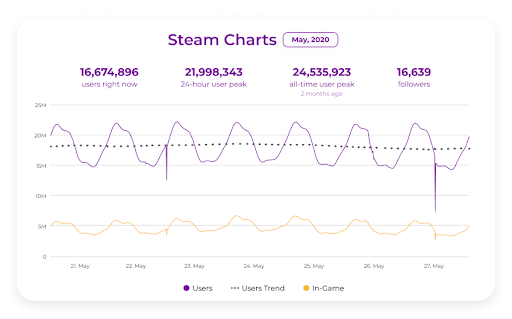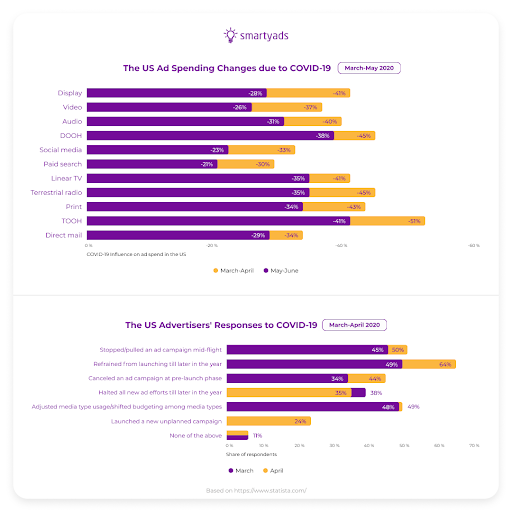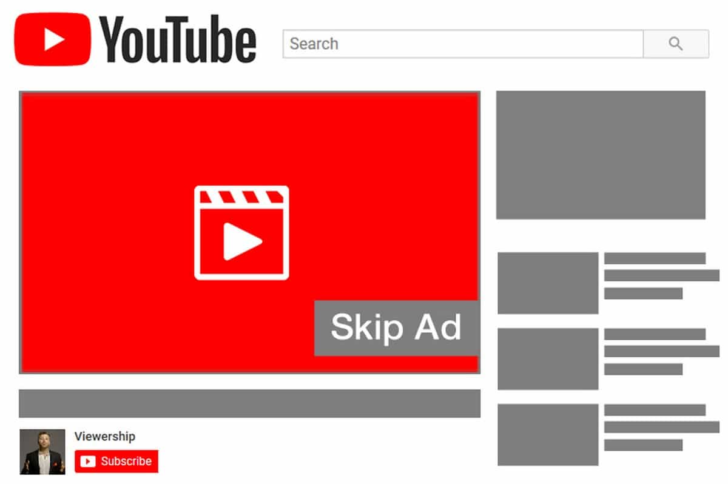30-second summary:
- Since the lockdown online video content has been steadily replacing traditional television as people spend more time streaming shows and playing video games.
- Advertisers are redistributing their ad budgets making stakes on CTV/ OTT and social media.
- 64% of advertisers terminated their ad campaigns while 24% used this period as an opportunity to launch something new.
- In-stream, shoppable, vertical, and short video formats are gaining momentum as social media traffic volumes are peaking.
- CEO of SmartyAds, Ivan Guzenko shares his thoughts on video advertising trends as he highlights the hottest video ad formats and resolutions.
Digital video advertising trends are booming – when six out of 10 people prefer watching videos online instead of watching TV, it is safe to say that online video content has replaced traditional television. More than 78% of people watch digital videos every week and 55% watch them every day. The penetration of over-the-top video streaming in the U.S. reached 57,3% of the population in 2019, and by the end of 2022, it will rise to 58,2%.
Just like Bill Gates once predicted oblivion to companies that ignored the Internet space, in 2020, something similar can be said about video marketing. In my last article, I mentioned how brands can apply video marketing strategies. Now, it’s time to discuss video advertising trends and explore new formats so that your brand can grasp new opportunities and establish a stronger connection with customers.
OTT and CTV ads
In this time of the coronavirus, TV experiences a dramatic surge in viewing – TV video content consumption has climbed 60% higher on all devices for streaming Smart TVs, and mobiles including. The most significant rise was noticed in categories like entertainment, news, and children’s content.  A record number of visitors on Steam was detected in May.
A record number of visitors on Steam was detected in May.
The platform gathered the largest number of visitors over the past 16 years: 21,998 players per 24 hours.
Thus, even though now many advertisers are forced to close their brick-and-mortar stores and postpone their ad budgets, more than a quarter of them plan to launch new campaigns as traffic across CTV medium peaks.

April’s data, meanwhile, confirms the growing demand regarding CTV and OTT viewership that outstretches across all dayparts. As seen from the chart below, TV viewership has seen a giant climb across popular channels.

Connected TV makes it easy for people to consume video content, how they like, and where they want, via Internet-connected gadgets. Thus, even after COVID-19 comes to an end, such TV consumption will only grow in comparison to a much less flexible linear experience. Currently, brands are massively redistributing their spending into CTV and OTT programmatic environments.
Those brands that embrace CTV and OTT programmatic platforms will be doubling their profits in the future, because only these technologies, so far, make TV ad campaign planning, attribution, and management as transparent as on the web. While planning an ad campaign on CTV pay attention to ad slots available at the beginning, in the middle, and at the end of streamed content. These ads are called pre-rolls, mid-rolls, and post-rolls, and they last for 15 to 30 seconds. In the same way, you can make use of in-stream ads that appear in the video content.
In-stream ads
So, familiar YouTube in-stream ads are still leading video advertising industry trends and aren’t going anywhere in the near future. After entering the mobile medium, they gained a new definition. These ads are built directly into the video stream, or on-demand videos, and they last for five to 15 seconds after initiation. In-stream ads usually perform very well and result in completion rates that reach 70% on Facebook.
Today, any brand can create short mid-rolls that are optimized for a particular purpose: raising brand awareness, engaging users, generating installs, views, etc. Within the March-May period, in-stream units that smoothly transition in the live-stream grew in demand for at least eight to 13% according to customer data gathered by SmartyAds DSP.

Personalized and shoppable videos
In 2020, about 71% of consumers prefer to receive personalized messages, which is why data-driven technologies are strategically important for every marketer. Platforms, like Facebook and YouTube, have already learned how to manipulate detailed video usage statistics to personalize ads. Additionally, last year, YouTube launched the “TrueView for Reach” option for short commercials, which analyzes the search queries to predict the relevance of advertising.
Instagram, meanwhile, has introduced a shop button, which redirects a customer to the landing directly from the promotional video (shoppable video). Tiktok is currently testing the same feature. Over 49% of advertisers plan to extend their video strategies by investing in smart, shoppable ads in the future since after the COVID-19 period people will be more inclined to online purchasing.

If you religiously keep up with 2020 video advertising trends, employ shoppable and personalized experiences in your video advertising strategy and forget about wasting money on irrelevant impressions. In order to personalize your ads, use the YouTube TrueView tool for short commercials, or choose programmatic advertising personalization. Programmatic technology determines the relevance of an impression based on arrays of collected user data sets that will fit not only video personalization, but also display, native, push, CTV, and other types of campaigns.
Social media video trends
The competition among brands that are trying to win an audience’s attention is difficult like never before. 81% of businesses regularly incorporate video advertising into their promotion strategies (with a 63% increase year-after-year). The freshest trends show that 45% of people spend time on social media (Facebook, Instagram, Twitter) more often so the trend is not random. At the same time, it’s no longer enough to reach existing and potential customers. The main objective now is involvement in brand experience by presenting information to the audience in the most convenient format and resolution. In the era of mobile-first experience, vertical videos, short formats, and stories are the best way to do so.
1. Vertical video format
Video advertising and social media trends reflect the most drastic changes in the mobile experience. That’s why such platforms like Instagram prefer to lead the trend and base their strategies on vertical videos. Stats claim that 40% of the top 1,000 most popular Instagram videos are generated by brands. Vertical video trends imply that videos need to be optimized according to the most convenient way of watching – vertical or horizontal (depending on the situation).

- According to the stats, 94% of people usually hold their mobile phones in a vertical position.
- 82% of people find it annoying watching a video that’s not optimized for the orientation they choose.
- Ads that are watched vertically, on average, have 90% higher completion rates than those watched horizontally.
- 40% of people who film videos with their own phones and produce user-generated content still prefer to keep their phones vertically and 60% horizontally.
So what should be considered before you fit videos to user experience? First of all, remember that most vertical videos can be found on social media and entertainment. Keep your audience in mind when optimizing the watching experience, and remember that, ideally, they should be pretty short approximately 15 seconds.
2. Short, yet memorable 15-second-long videos
World video advertising trends tipped marketers off that people prefer brands that appreciate their time. Thus, video content should be crafted so that it easily grabs attention and lingers in the memory, despite the fact that the ad unit duration barely reaches 15 seconds. Sounds like mission impossible, but that’s what the market demands now – 73% of video advertising commercials never exceed the two-minute ‘boredom bar.’
Last year, brands started to actively transform their long videos into bumper ads — a six-second long video format that drives an enormous lift in memorability. For potential customers, six-second video views are perfect. From the customer’s standpoint, such ads help to stay away from excessive details, yet it is enough to resurface the brand in the memory when a purchase is being planned.
Short videos can work wonders for both brand-awareness and performance ad campaigns alike. These ad units are much less annoying than other video types, but they’re also cost-effective tools that drive upper-funnel and bottom-funnel goals for companies with humble ad budgets. At the same time, your ads don’t always have to be 6-seconds long – create and test 6/15/30 second-long videos, include a call-to-action and recognizable brand elements to see how your audience reacts. The shortest version can be set prior to a 30-second ad that runs at the smaller section of the screen and so forth.
3. Stories
Ad formats, such as stories, have also been popular on social media (for a long time). If Instagram stories involuntarily pop into your mind, remember that now it is also used by Facebook and Snapchat, and even LinkedIn is currently testing the waters.
Clearly, video narratives are gaining momentum. Create a story about your brand and pack it into stories format: intrigue first, give clues, and finally, craft a catchy ending. Finally, encourage your audience to create custom content – now they have the opportunity to easily do so on their phones. Good stories and user-generated content will always leave a pleasant aftertaste and increase interest in your brand. During the pandemic, you can also ask your customers to participate in a challenge by using interactive stickers or solicit feedback and opinion surveys.
In closing
In 2020, using the latest trends in video advertising is a sure way to break through informational noise and win the hearts of your potential customers. User-generated content, vertical videos on social media, stories, and short creatives – video marketing is steadily growing user-centric.
Brands need to understand that this is a new challenge. Instead of force-feeding your audience with irritating and irrelevant commercials, choose the right format and resolution. Finally, give preference to data-driven personalization to amplify the effect of your message to let it reach the right audience at the right time.
Ivan Guzenko is CEO of SmartyAds. He can be found on Twitter @ivanguzenko.
The post Hottest user-centric video advertising trends of 2020: CTV, vertical, and social formats appeared first on Search Engine Watch.
from Search Engine Watch https://ift.tt/3dX4gem

No comments:
Post a Comment